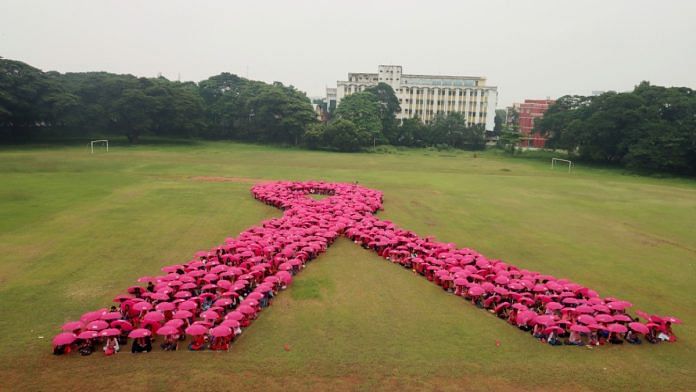New Delhi: Women in the Asia Pacific (APAC) region are at a disproportionately higher risk of developing breast and cervical cancers when compared to those worldwide, an Economist report has found.
The ‘Impact and Opportunity: the Case for Investing in Women’s Cancers in Asia Pacific’ report, sponsored by Roche and published by Economist Impact, examines the burden of breast and cervical cancers on six Asian countries – India, Indonesia, Malaysia, the Philippines, Thailand and Vietnam – and identifies market-specific gaps and opportunities for improvement.
The report also says with limited awareness, stigma, and a lack of access to quality and timely screening, diagnosis, treatment, and care services, women in low- and middle-income countries have inferior outcomes when it comes to breast and cervical cancers.
Breast cancer is further anticipated to climb by 20.9 per cent in Asia between 2020 and 2030, while death will rise by 27.8 per cent. At the same time, the incidence of cervical cancer is predicted to rise by 18.9 per cent, while death will rise by 24.9 per cent, the report found.
About 2.3 million cases of breast cancer were diagnosed globally in 2020, with almost half in Asia (45 per cent). Breast cancer was found to be the fourth most common cancer in India at 26.3 per cent.
Some cancers were found to affect women differently than men due to specific gender-related risk factors such as incidence, care, and death. The report also found that cervical cancer was the second-most common disease affecting women and female breast cancer surpassed lung cancer as the most common newly-diagnosed cancer worldwide in 2020.
Also read: WHO warns of ‘cancer risk’ from aspartame, but ‘38% urban Indians’ use artificial sweeteners monthly
Impact on health expenditure
According to the report, India also saw a 40 per cent increase in breast cancer incidence in the past two decades.
Countries with lower middle- or upper middle-income, are set to witness a rise in breast and cervical cancers and mortality that match or exceed anticipated regional and global averages, the report further revealed.
It highlighted the global burden of cervical cancer heavily weighted towards Asia, with 58 per cent of all cases arising on the continent in 2020. It was the second most common cancer in women in India (18.3 per cent) followed by Indonesia (17.2 per cent) and the Philippines (9.1 per cent).
Asia was also found to have the world’s highest death rate from cervical cancer, with more than 58 per cent of all deaths related to it.
In India, nearly 70 per cent of cervical cancers are diagnosed at an advanced stage (Stages III or IV), making treatment more complex and expensive and decreasing the chance of survival. Moreover, cervical cancer patients in India spend Rs 4,042 to Rs 23,453 per patient and the cost of treatment results in nearly 62 per cent of patients incurring catastrophic health expenditures.
The report analysed five factors to learn more about the current gaps and opportunities: policy and planning; prevention and screening; diagnostics and resource capacity; treatment and access; and awareness and education.
Some significant parts of these categories, such as relatively recent National Cancer Control Plans (NCCPs), HPV vaccination programmes, and awareness and education programmes, were already in place to some extent across the six nations.
However, crucial diagnostic technologies for breast and cervical cancer, such as mammography, biopsy, next generation sequencing, CT scanning, and genetic testing, were unavailable in the public sector. There are also difficulties in resolving cancer care access gaps in rural and impoverished regions.
Healthcare spending as a proportion of GDP is less than 3 per cent in India. Moreover, while G20 countries launched 16 per cent of new medicines within one year in 2012-21, India launched only 2 per cent. The average delay in launching new medicines was 42 months in India. India is also the only country where the National Cancer Control Plan was updated last in 2016.
In terms of implementation, two countries — India and the Philippines — lack specific targets to achieve cervical cancer elimination. India also lacks a guideline in line with recommendations set out by the WHO, especially for cervical cancer. India, however, scored high in healthcare capacity with 17.5 mammograms per 10,000.
Way forward
The WHO’s Global Strategy for Cervical Cancer Elimination includes the “90-70-90” targets, which should be met by 2030 for countries to be on the path towards cervical cancer elimination. These include achieving 90 per cent complete HPV vaccination rates for girls under 15, screening 70 per cent of women with a high-performance test by age 35 and again at 45, treating 90 per cent of women with precancerous lesions or invasive cancers.
“The critical health risks confronting women in the APAC region are undeniable,” said Ahmed Elhusseiny, Area Head, Roche Pharmaceuticals Asia Pacific.
Data suggests this strategy will be cost-effective in 74 of 78 lower-income and lower middle-income countries (LMICs). According to the WHO, achieving the 90-70-90 goals in LMICs will prevent 300,000 cervical cancer deaths by 2030, and the median cervical cancer incidence rate will fall by 42 per cent by 2045.
Also read: Yellapragada Subbarow pioneered cancer research, but his US professor sabotaged his career



